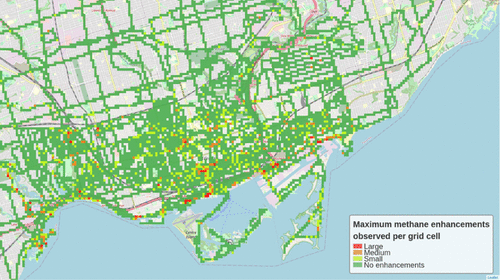当前位置:
X-MOL 学术
›
Environ. Sci. Technol.
›
论文详情
Our official English website, www.x-mol.net, welcomes your
feedback! (Note: you will need to create a separate account there.)
Investigation of the Spatial Distribution of Methane Sources in the Greater Toronto Area Using Mobile Gas Monitoring Systems
Environmental Science & Technology ( IF 10.8 ) Pub Date : 2020-11-24 , DOI: 10.1021/acs.est.0c05386 Sebastien Ars 1, 2 , Felix Vogel 1 , Colin Arrowsmith 2 , Sajjan Heerah 3 , Emily Knuckey 2 , Juliette Lavoie 2 , Christopher Lee 2 , Nasrin Mostafavi Pak 2 , Jaden L. Phillips 2 , Debra Wunch 2
Environmental Science & Technology ( IF 10.8 ) Pub Date : 2020-11-24 , DOI: 10.1021/acs.est.0c05386 Sebastien Ars 1, 2 , Felix Vogel 1 , Colin Arrowsmith 2 , Sajjan Heerah 3 , Emily Knuckey 2 , Juliette Lavoie 2 , Christopher Lee 2 , Nasrin Mostafavi Pak 2 , Jaden L. Phillips 2 , Debra Wunch 2
Affiliation

|
For methane emission reduction strategies in urban areas to be effective, large emitters must be identified. Recent studies in U.S. cities have highlighted the contribution of methane emissions from natural gas distribution networks and end use. We present a methane emission source identification and quantification method for the Greater Toronto Area (GTA), the largest metropolitan area in Canada, using mobile gas monitoring systems. From May 2018 to August 2019, we collected 77 surveys of methane mixing ratios, covering a distance of about 6400 km, and sampled emission plumes from sources such as closed landfills, natural gas compressor stations, and waterways. Our results indicate that inactive landfills emit less than inventory estimates. Despite this discrepancy, we confirm that the waste sector is the largest methane emitter in the GTA. We also report that the frequency of methane leaks from the local distribution system ranges between 4 and 22 leaks per 100 km of roadway in downtown Toronto, which is comparable to the range observed in U.S. cities, which have invested in modern natural gas distribution infrastructure. Last, we find that engineered waterways, whose emissions are currently not reported in inventories, may be a significant source of methane.
中文翻译:

利用移动气体监测系统调查大多伦多地区甲烷气源的空间分布
为了使城市地区的甲烷减排策略有效,必须确定大型的排放者。美国城市的最新研究强调了天然气分销网络和最终用途中甲烷排放的贡献。我们使用移动式气体监测系统为加拿大最大的大都市区大多伦多地区(GTA)提供了一种甲烷排放源识别和量化方法。从2018年5月到2019年8月,我们收集了77个甲烷混合比的调查,覆盖了约6400 km的距离,并从封闭的垃圾填埋场,天然气压缩机站和水路等来源采样了排放羽流。我们的结果表明,不活跃的垃圾填埋场的排放量少于库存估算值。尽管存在这种差异,但我们确认废物处理部门是GTA中最大的甲烷排放方。我们还报告说,多伦多市区每100公里道路甲烷泄漏的频率介于4至22个泄漏之间,这与美国城市投资的水平相当,后者已投资于现代天然气配送基础设施。最后,我们发现工程水道(其排放目前尚未在清单中报告)可能是甲烷的重要来源。
更新日期:2020-12-15
中文翻译:

利用移动气体监测系统调查大多伦多地区甲烷气源的空间分布
为了使城市地区的甲烷减排策略有效,必须确定大型的排放者。美国城市的最新研究强调了天然气分销网络和最终用途中甲烷排放的贡献。我们使用移动式气体监测系统为加拿大最大的大都市区大多伦多地区(GTA)提供了一种甲烷排放源识别和量化方法。从2018年5月到2019年8月,我们收集了77个甲烷混合比的调查,覆盖了约6400 km的距离,并从封闭的垃圾填埋场,天然气压缩机站和水路等来源采样了排放羽流。我们的结果表明,不活跃的垃圾填埋场的排放量少于库存估算值。尽管存在这种差异,但我们确认废物处理部门是GTA中最大的甲烷排放方。我们还报告说,多伦多市区每100公里道路甲烷泄漏的频率介于4至22个泄漏之间,这与美国城市投资的水平相当,后者已投资于现代天然气配送基础设施。最后,我们发现工程水道(其排放目前尚未在清单中报告)可能是甲烷的重要来源。











































 京公网安备 11010802027423号
京公网安备 11010802027423号